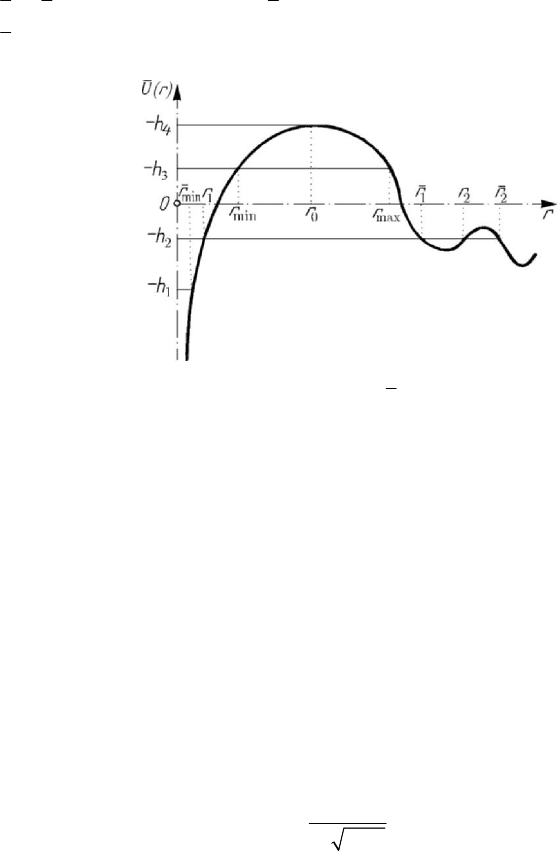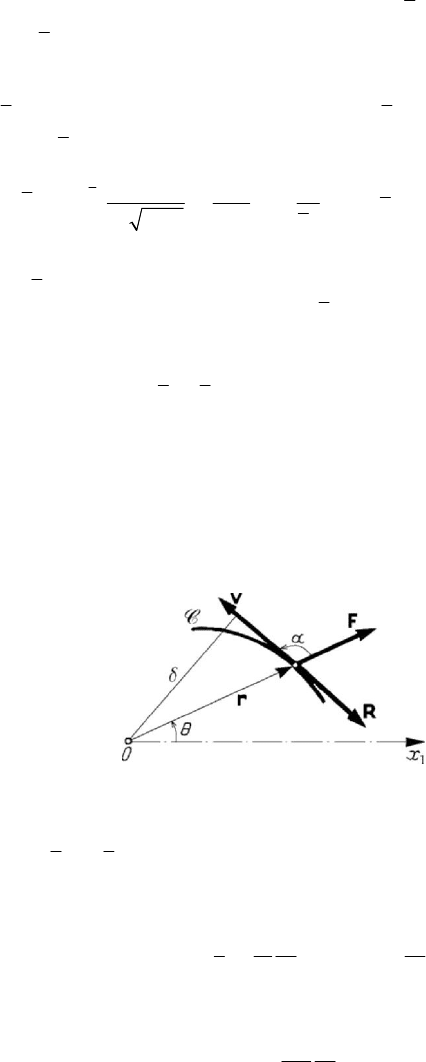Teodorescu P.P. Mechanical Systems, Classical Models Volume I: Particle Mechanics
Подождите немного. Документ загружается.


MECHANICAL SYSTEMS, CLASSICAL MODELS
472
where we have introduced the apparent potential
()Ur and the constant of energy h ;
hence
00
00
2
d(1 / )
d
() ()
rr
rr
CC
ρ
ρ
θθ θ
ϕρ ρ ϕρ
=± =
∫∫
∓ ,
[]
2
() ()rUrh
m
ϕ =+
,
(8.1.6'')
the trajectory in polar co-ordinates being thus specified. The two first integrals used
above allow also to put in evidence the motion of the particle along the trajectory,
establishing its parametric equations in the form
0
2
0
1
()dtt r
C
θ
θ
ϑϑ=+
∫
,
0
0
d
()
r
r
tt
ρ
ϕρ
=±
∫
.
(8.1.6''')
If the potential is of the form
() /
s
Ur k r
=
, constk
=
, s
∈
, then the above
integrals may be expressed by elementary functions only if
2s =− (harmonic
oscillator),
1s =− , 1s = (Keplerian motion) and 2s
=
; if
6, 4, 3,4, 6s
=
−−
, then
these integrals may be expressed by means of elliptic functions.
The sign before the radical is determined by the sign of the initial velocity
00
()rrt=, as long as () 0rϕ > . If () 0rϕ
=
, it results that
0
0
0
r
vr
=
= , so that the
velocity is normal to the radius vector at the initial moment; the motion along the radius
vector takes place as this radius would be fixed, the force which acts upon the particle
being
F . If this apparent force is positive (repulsive force), then r is increasing and
takes the sign +; otherwise, one takes the sign –. In particular, let us suppose that
0F =
at the initial moment; in this case, the particle remains immovable for an
observer on the radius vector, because the particle moves along this radius as if it would
be fixed, the particle being launched without initial velocity at a point in which the
apparent force vanishes. Hence, the trajectory is a circle of radius
0
r , the motion being
uniform (because the areal velocity is constant).
To have a circular trajectory, it is necessary that
0
/2απ
=
± (the velocity be
normal to the radius vector at the initial moment, so that
00
Crv=±
) and
23
00
() / 0Fr mC r+=
. If
0
rr
=
(circular motion) and
0
θθ
=
(uniform motion),
then – during the motion – the equation (8.1.4) is identically verified; the initial
conditions being fulfilled, the theorem of uniqueness ensures the searched solution. The
velocity at the initial moment has thus the modulus
00
0
()Fr r
v
m
−
=
;
(8.1.7)
hence, at the initial moment, the force
F must be of attraction (
0
() 0Fr < ).
The relation (8.1.4) may be written also in the form
(
)
22
22
d1 1
d
mC
F
rr
r θ
⎡
⎤
=− +
⎢
⎥
⎣
⎦
;
(8.1.8)

Dynamics of the particle in a field of elastic forces
473
we obtain thus Binet’s formula, which allows to solve the inverse problem: to determine
the central force which, applied upon a given particle, imparts a plane trajectory to it,
after the law of areas with respect to a fixed pole. Taking into account the equation
(8.1.4') of the trajectory, we can write
[]
2
2
() ()
mC
Fff
r
θθ
′′
=− +
(8.1.8')
too, where
22
/
f
f θ
′′
≡∂ ∂ . If beforehand a form of F is not imposed, that one has a
certain non-determination, taking into account the equation of the trajectory (the
equation which links
r to θ ); eliminating θ , one obtains ()FFr
=
, form used the
most times.
For instance, in case of trajectories to which corresponds the equation
cos
k
rakbθ=+, ,, constabk
=
,
(8.1.9)
choosing the fixed point as origin, we get
(
)
22
2
3
(1)
() ( 2)
kk
kab
C
Fr k b
rr
+
+−
⎡
⎤
=− + +
⎢
⎥
⎣
⎦
;
(8.1.9')
in particular, these trajectories may be conics with the pole at the focus (
1k =− ) or at
the centre (
1k = ), Pascal limaçons ( 2k
=
, 0b
=
), lemniscates etc.
1.1.2 Qualitative study of orbits. Bertrand’s theorem
Usually, the trajectory of a particle in a central field of forces is called orbit (even if
it is not a closed curve). The relations (8.1.6')-(8.1.6''') determine the orbit and the
motion on it only if
r
,
θ
and
t
are real quantities, hence if () 0rϕ ≥ ; the apparent
potential must verify the condition
() 0Ur h
+
≥
, which determines the domain of
variation of
r , corresponding to the motion of the particle; the solutions of the equation
() 0Ur h
+
=
(8.1.10)
specify the frontier of the domain. From (8.1.6') one may see that the radial velocity
vanishes on the frontier (
0r
=
), the angular velocity being non-zero ( 0θ ≠
); if
we would have
0θ =
at a point other than the origin, then the first integral of areas
would lead to
0C =
, that is to a rectilinear trajectory; hence, at the respective points
the velocity is normal to the radius vector. On the frontier,
()rt changes of sign, the
respective point corresponding to a relative extremum for
()rt . The relation (8.1.2)
shows that
()tθ
has a constant sign, so that ()tθ is a monotone function; the integrals
(8.1.6''), (8.1.6''') must be calculated on intervals of monotony, the sign being
chosen correspondingly. Let
min
r and
max
r be the extreme values which may be taken
by
r ; the corresponding points on the orbit are called apsides. In this case,

MECHANICAL SYSTEMS, CLASSICAL MODELS
474
max
min
0 rrr≤≤≤. The roots of the equation (8.1.10) may be graphically
determined, taking into consideration the intersection of the apparent potential
()UUr= with the straight line Uh
=
− ; the domain of variation of r corresponds to
()Ur h≥− (Fig.8.2).
Figure 8.2. Diagram ()Ur vs
r
.
Let us consider first of all the case of a motion to which corresponds the constant
3
h
of energy. The radius
max
r
is finite, the orbit is bounded, while the trajectory is
contained in the annulus determined by the circles
min
rr
=
and
max
rr
=
(we assume
that
min
0r > ); the radii
min
r and
max
r are called apsidal distances. The points for
which
min
rr
=
are called pericentres, while those for which
max
rr
=
are called
apocentres. Noting that at an apsis the velocity is normal to the radius vector, which is
the radius of a circle, it results that the trajectory is tangent to the concentric circles at
the corresponding apsides. Choosing the origin of the angles after an apsis radius
(
0
0θ = ), called apsidal line, we may use the relation (8.1.6'') for two points of the
same radius vector
r of the trajectory, on both sides of that line,
0
r being
min
r or
max
r ; it results that the trajectory of the particle is symmetric with respect to an apsidal
line. The angle at the centre
χ between two consecutive apsidal lines is constant; it is
called apsidal angle and is given by
max
min
2
d
()
r
r
r
C
rr
χ
ϕ
=
∫
.
(8.1.11)
It results that the angle at the centre between two consecutive pericentres (apocentres) is
equal to
2χ
. From the above mentioned properties, it results that if one knows the arc
of trajectory between two consecutive apsides, then one may set up geometrically the
whole trajectory (Fig.8.3). From (8.1.2) it results that
θ
has a constant sign, so that the
particle is rotating always in the same direction around the point
O . A bounded orbit is
closed if, after a finite number of such rotations, the particle returns to a previous

Dynamics of the particle in a field of elastic forces
475
position; thus, the condition
22qχπ
=
,
q
∈
must be satisfied. Otherwise, the orbit
is open and covers the annulus
[
]
max
min
,rrr
∈
. We also notice that the apparent
potential
()Ur has a maximum at a point in the interior of the annulus, corresponding
to
() d ()/d 0Fr Ur r==. We mention that the equation () 0rϕ
=
can have more
than two roots (the case of the constant
2
h of energy, Fig.8.2). In this case, one obtains
two possible annular domains (contained between the circles of radii
1
r and
1
r or
2
r
and
2
r , respectively); the motion takes place in that domain in
Figure 8.3. Orbit of a particle acted upon by a central force.
which is the initial position given by
00
()rrt
=
. If
min
0r
=
, then the particle passes
through the pole
O or stops at that point. Assuming that 0C
≠
(otherwise, the
trajectory is rectilinear), the term
22
/2mC r− allows to have
0
lim ( )
r
Ur
→
=−∞, the
“falling” towards
O being thus hindered. The condition of “falling” towards O is
given by the condition
Uh≥− , written in the form
222
() /2rU r mC hr−≥−. To
have
min
0r
=
it is necessary that
2
2
00
lim ( )
2
r
mC
rU r
→+
≥
⎡⎤
⎣⎦
,
hence that ()Ur tends to zero at least as
2
/Ar,
2
/2AmC> , or as /
n
Ar, 0A > ,
2n >
.
If
max
0
min
rr r
=
= , then the trajectory is a circle of radius
0
r , corresponding
() 0Fr =
and the constant of energy
max
4
hU=−
(Fig.8.2); the considerations made
at the previous subsection remain valid.
One may prove

MECHANICAL SYSTEMS, CLASSICAL MODELS
476
Theorem 8.1.1 (J. Bertrand). The only closed orbits corresponding to central forces
are those for which
2s =−
,
0k
<
, in any initial conditions, or
1s =
,
0k >
, in
certain initial conditions, assuming a potential of the form
() /
s
Ur k r
=
,
constk =
,
s ∈
.
1.1.3 Case of a force the modulus of which is in inverse proportion to the square of
the distance to a fixed point
Jacobi has considered the case in which the central force is of the form
2
()/Frγθ= , hence it is in inverse proportion to the square of the distance to the pole
O . Binet’s equation (8.1.4) takes the form
(
)
2
22
()
d1 1
d
rr
mC
γθ
θ
+=− ;
(8.1.12)
by integration, one obtains
12
1
cos sin ( )CC
r
θθγθ=++,
(8.1.12')
where
()γθ is a particular integral, which may always be calculated by quadratures.
The integration constants are easily obtained by initial conditions of Cauchy type.
Analogously, we may consider central forces of the form
3
/kr, constk = , which
lead to the equation
(
)
(
)
2
22
d1 1
10
d
k
rr
mC
θ
+
+=,
(8.1.13)
wherefrom it results the general integral
12
1
cos sinCC
r
βθ βθ=+,
2
1/kmCβ =+ .
(8.1.13')
1.2 Other problems
We consider now two other problems, i.e.: the problem of two particles, which leads
to the classical case of action of central forces and the problem of motion of a particle
subjected to the action of a central force in a resistent medium. We study the
phenomena of capture and diffraction too.
1.2.1 The problem of two particles. Capture. Diffraction
Let be two bodies which may be modelled by two particles
1
P and
2
P of position
vectors
1
r and
2
r and of masses
1
m and
2
m , respectively (Fig.8.4). We suppose that
this system of particles is acted upon only by the internal forces
21 12 12 21
vers versFF=− = =−FF r r,
12 2 1 21
=
−=−rrr r, where 0F > in case

Dynamics of the particle in a field of elastic forces
477
of repulsive forces and
0F
<
in case of forces of attraction. From the equations of
motion
11 21
m =−
rF
,
22 21
m
=
rF
, amplifying by
2
m and
1
m , respectively, and
subtracting, one obtains
12 21
m =
rF
,
21 12
m
=
rF
,
12
111
mm m
=+,
(8.1.14)
where
m is the reduced mass. These equations describe the motion of the particle
2
P
with respect to the particle
1
P (as if the latter one would be fixed), as well as the motion
of the particle
1
P with respect to the particle
2
P ; in such conditions, the force
21
F and
the force
12
F are central forces, respectively, and one may use the results previously
obtained.
Figure 8.4. Problem of the two particles.
These considerations allow to study also the case in which
max
r is not finite, the
orbit being unbounded. We must have
lim ( ) lim ( )
rr
hUr UrU
∞
→∞ →∞
−≤ = = . To fix the
ideas, we assume that
0U
∞
=
; because the integral ()d
r
UFrr
∞
∞
=
∫
must have a
sense, we suppose that
F
tends to zero for r →∞ at least as
1
1/r
ε+
,
0ε >
. The
condition of “escape” at infinity becomes
0h ≥
. Indeed, if we assume that the particle
1
P
is situated at the centre
O
, while the particle
2
P
tends to infinity, the interaction
ceases and one has
0U
∞
= ; the particle
2
P
is endowed, in this case, only with kinetic
energy
T
, so that
0Th=≥
. The symmetry of the trajectory with respect to the line
of the pericentre remains valid (the same as in the case of bounded orbits); we notice
that the unbounded orbits have only one pericentre and pass only once through it.
If the particle
2
P
comes from infinity and enters in interaction with the particle
1
P
,
then may appear the phenomenon of capture (
12
rr
=
remains finite or vanishes for
t →∞) or the phenomenon of diffraction (r →∞ for t →∞). We notice that
Cbv
=
,
2
2
mv
h =
,
(8.1.15)
where
00
21
=−vv v is the relative velocity at the initial moment, while b is the
distance from
1
P to the support of the velocity. The formula (8.1.6''') where we take

MECHANICAL SYSTEMS, CLASSICAL MODELS
478
0
0t = gives the time in which the particle coming from infinity reaches a position at
finite distance in the form
d
()
r
t
ρ
ϕρ
−∞
=−
∫
;
(8.1.16)
we noticed that the radial velocity is directed towards the particle
1
P
. One has a real
motion only if
() 0rϕ > ; we observe that
2
()2/ 0hm vϕ
−
∞= = >
. Thus, if the
time
t increases, then the radius vector r decreases.
Figure 8.5. Capture: at a pole (a); on a circle (b).
For
t →∞ we may have 0r → , obtaining the phenomenon of capture; the
trajectory of the particle
2
P is thus a spiral which tends to the pole O (Fig.8.5,a). But if
there exists a radius
r for which () 0rϕ
=
, then we may write
() ( ) ()rrr r
ν
ϕψ=− , () 0rψ
≠
. The integral (8.1.16) is divergent if 2ν ≥ , while
rr→ for t →∞; we obtain a phenomenon of capture too in which the trajectory of
the particle
2
P is also a spiral wrapped up a circle of radius rr
=
(Fig.8.5,b). The
phenomenon of capture may take place only in case of forces of attraction between the
two particles.
Figure 8.6. Diffraction: force of attraction (a); repulsive force (b).
If
2ν < , then the integral (8.1.16) is convergent so that there exists a finite moment
t for which rr= , () 0rϕ
=
(
min
rr
=
is the minimal value of r corresponding

Dynamics of the particle in a field of elastic forces
479
to a constant of energy
1
h , Fig.8.2); the respective point P is a pericentre, while the
apsidal line
OP is a symmetry axis of the trajectory, which has the form in Fig.8.6,a, in
case of forces of attraction, or the form in Fig.8.6,b, in case of repulsive forces. One
obtains thus the phenomenon of diffraction. The apsidal angle is expressed in the form
χπθ=−, in case of a force of attraction, and by χθ
=
, in case of a repulsive force,
where the angle
θ is given by the formula (8.1.6'')
2
d
()
r
r
C
rr
θ
ϕ
−∞
=
∫
,
22
2
1()0
2
mv b
Ur
r
⎛⎞
−
+=
⎜⎟
⎝⎠
.
(8.1.17)
The angle
formed by the asymptotic direction of the trajectory with the support of
the velocity
v (in fact, the angle of the two asymptotes to the trajectory) is called
diffraction angle and is given by
(2)πθ=−∓
, where one takes the sign – or the
sign + as the diffraction is of attraction or is repulsive, respectively. If we denote by
“prime” the quantities which intervene after the interaction (for
t →∞), the relations
(8.1.15) show that
bb
′
= , vv
′
=
; hence, the magnitude of the relative velocity is
conserved, the velocity vector changing only with the diffraction angle.
1.2.2 Motion of a particle acted upon by a central force in a resistent medium
This case of motion generalizes the case previously considered; obviously, it leads to
a plane trajectory
C too, the resistance R of the medium being tangent to the
trajectory and opposed to the motion (Fig.8.7). Hence, the equation of motion is of the
form
Figure 8.7. Particle acted upon by a central force in a resistent medium.
mF R
rv
=−
rr
r
, (,,, ;)FFrrtθθ=
, (,,, ;)RRrrtθθ=
;
(8.1.18)
in polar co-ordinates, we have
()
2
r
mr r F R
v
θ−=−
,
()
2
d
d
mr
rR
rt v
θ
θ
=−
.
(8.1.18')
Eliminating the resistance
R between these equations, it results
()
22
2
d
d
r
Fmrr r
t
r
θθ
θ
⎡
⎤
=−−
⎢
⎥
⎣
⎦
.

MECHANICAL SYSTEMS, CLASSICAL MODELS
480
We return to the calculus in Subsec. 1.1.1 and assume that
0F
=
; hence, we get
()
() ()
2
2
22
2
22 2
d1 1 d1 1
dd
mr
Fmv
rr rr
r
θ
θ
θθ
⎡⎤⎡⎤
=− + =− +
⎢⎥⎢⎥
⎣⎦⎣⎦
,
(8.1.19)
generalizing thus Binet’s formula (8.1.8).
In this case, the areal velocity is no more constant (we can no more write a first
integral of areas). Noting that
2
/2rΩθ=
, the second equation (8.1.18') leads to
d
(ln )
d
R
tmv
Ω
Ω
Ω
==−
.
(8.1.20)
We observe that
/2vΩδ= , where δ is the distance from the pole O to the support
of the velocity
v
(Fig.8.7); we may write
2m
R
Ω
δ
=−
(8.1.20')
too, so that the resistance of the medium is in direct proportion to the areal acceleration;
as well, we obtain the relation
(
)
2
22
d
4d 2
dd
mm
R
ss
Ω
ΩΩ
δδ
=− =− .
(8.1.20'')
In particular, in case of a resistance of the form
2
Rkmv= , constk
=
, 0k > , we
obtain
d(ln ) d dkv t k sΩ =− =− , where s is the curvilinear co-ordinate along the
trajectory; it results
0
ks
eΩΩ
−
=
,
(8.1.21)
so that the areal velocity decreases exponentially.
2. Motion of a particle subjected to the action of an elastic
force
In case of a conservative central force for which
2
() /2Ur kr=− or
2
() /2Ux kx=− , 0k > (one of the two cases considered in Bertrand’s theorem), one
obtains an elliptic oscillator (with two degrees of freedom) or a linear oscillator (with
only one degree of freedom), respectively; the force which derives from this potential is
an elastic force. We consider also the corresponding damped and sustained (including
self-sustained) oscillations. A particular attention is given to repulsive elastic forces
(
0k < ), as well as to a study of non-linear oscillations.

Dynamics of the particle in a field of elastic forces
481
2.1 Mechanical systems with two degrees of freedom
In what follows, we study the non-damped and damped elliptic oscillator, in case of
elastic forces of attraction as well as in case of repulsive elastic forces; the case of self-
sustained oscillations is also taken into consideration.
2.1.1 Elliptic oscillator
In case of central forces of the form
()versFr
=
Fr, we may assume for ()Fr a
development into a Maclaurin series
2
(0) (0)
( ) (0) ...
1! 2 !
FF
Fr F r r
′
′′
=+ + +
.
(8.2.1)
We take
(0) 0F = , assuming that the pole O is a position of equilibrium. In case of
small motions (for which
1r , the unit having the dimension of a length) we neglect
the powers of higher order. We denote
(0)Fk
′
=
− , 0k > ; the force is thus directed
towards the centre
O , considering that one as a stable position of equilibrium. A force
of the form
verskr k
=
−=−Frr
(8.2.2)
is called elastic force (in fact, in the following, by elastic force we mean an elastic force
of attraction).
Figure 8.8. Model of an elastic force.
In the case in which the force
F has a fixed support (along the Ox -axis) we may
write
()Fx kx=− , modelling thus the force by an elastic spring of elastic constant
(coefficient of elasticity)
k , fixed at one end and acted upon by a force F due to a mass
m at the other end; the particle is modelled by a rigid body the motion of which is
guided (Fig.8.8). The denomination given to this force is thus justified.
The corresponding apparent potential is
()
22
222222
22
()
22 2
2
kmC m C m
Ur r r r
rr
ωωθ
⎛⎞
=− − =− + =− +
⎜⎟
⎝⎠
,
k
m
ω =
,
(8.2.3)
where we have taken into consideration the constant of areas (8.1.2); the graphic of this
function is given in Fig.8.9, where the graphics of the two component terms are put into
evidence. In case of a constant of energy
h for which ()Ur h≥− we obtain a bounded
